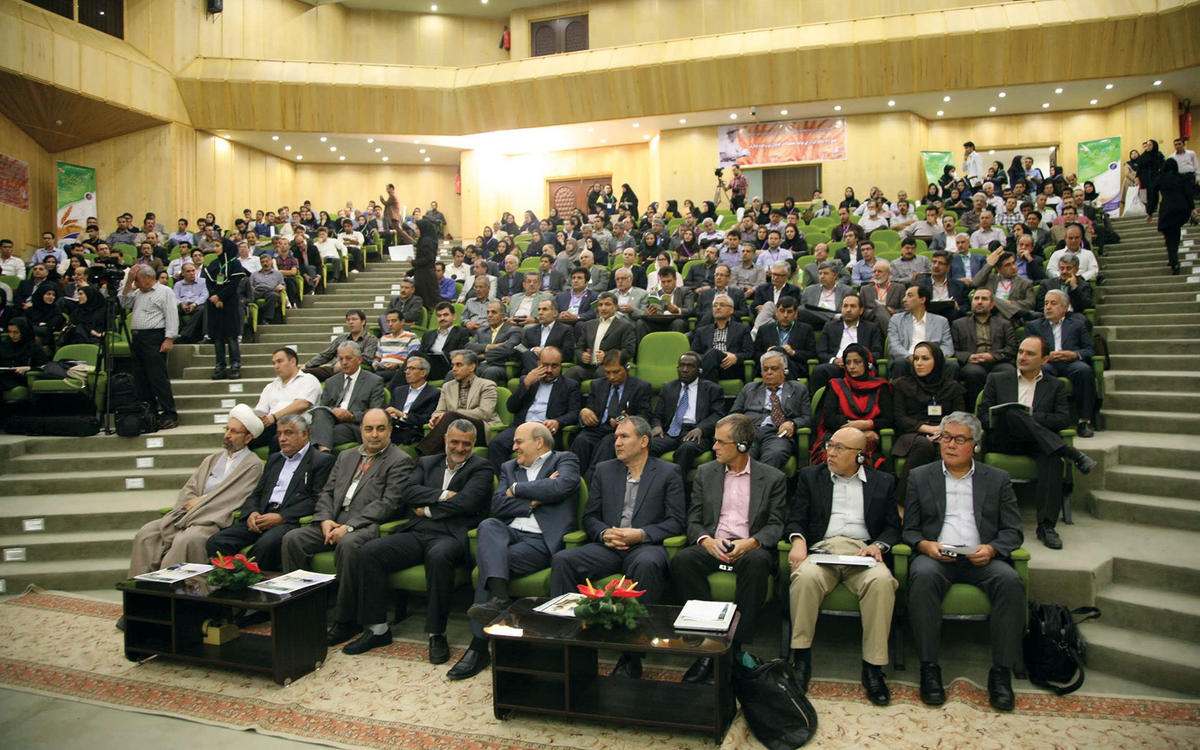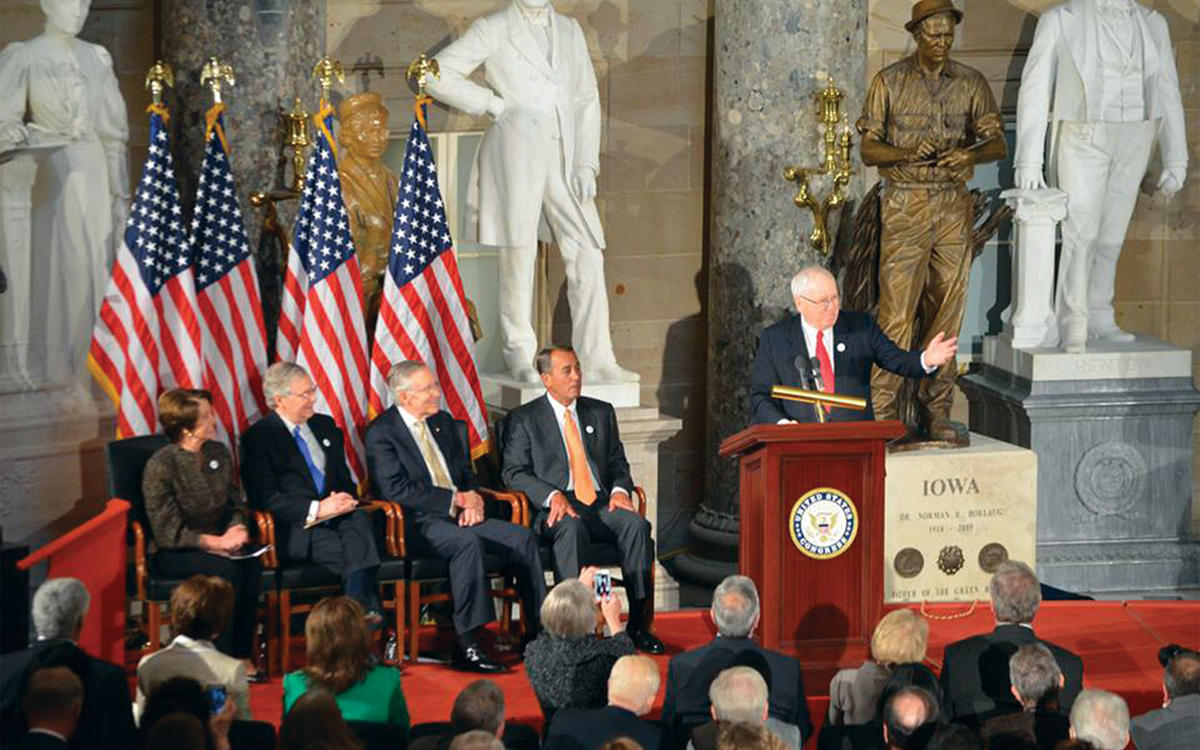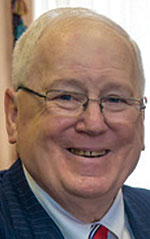Norman Borlaug and Biotechnology Lead a U.S. Ambassador to Iran
In this unusual example of the value of soft power, the often-divisive issue of biotechnology enabled the United States and Iran to find common ground.
BY KENNETH QUINN

Held at the Institute’s campus in Karaj, the symposium commemorating Norman Borlaug at the Agricultural Biotechnology Research Institute of Iran on Aug. 26, 2014 drew more than 400 Iranian scientists and students and 10 international guests. Among the senior government officials in attendance were Hujjat al-Islam Mr. Hossein Saeidian, the official representative of the Grand Ayatollah (front row, left), and Mahmoud Hojjati, Iran’s agriculture minister (fourth from left).
Courtesy of Kenneth Quinn

Kenneth Quinn addresses the symposium.
Courtesy of Kenneth Quinn
On March 25, 2014, long after I retired from the Foreign Service, I had the opportunity to address the joint leadership of the Congress as part of a ceremony in Statuary Hall at the U.S. Capitol. As chairman of the Dr. Norman E. Borlaug Statue Committee, I was there to unveil the magnificent bronze likeness of Borlaug, an Iowa farm boy whose miracle wheat saved hundreds of millions from famine, starvation and likely death in India, Pakistan and the Middle East during the 1960s.
It was truly a magical moment to speak to an overflow audience in the heart of our democracy as we installed Dr. Borlaug’s statue in the pantheon of great Americans in history. That this ceremony took place on the 100th anniversary of his birth added to the sense of grandeur that surrounds his extraordinary legacy.
Little did I know that within just months, at a time when U.S.-Iranian relations were full of tension over Tehran's nuclear program and behind-the-scenes negotiations on the matter had yet to reach fruition, I would have the opportunity to take the extraordinary Borlaug legacy to Iran. It was an unusual diplomatic experience, one of the most memorable in my post-Foreign Service career.
Who Was Norman Borlaug?
Dubbed the “Father of the Green Revolution,” Borlaug received the Nobel Peace Prize in 1970, and subsequently was awarded the Presidential Medal of Freedom and the Congressional Gold Medal, our country’s highest civilian honor—making him one of only three Americans to receive all three of those honors. (The other two were Martin Luther King Jr. and Elie Wiesel.)
It had been my incomparable privilege to work closely with Dr. Borlaug for more than a decade as president of The World Food Prize, which he founded, and which is headquartered in my home state of Iowa. I spent those years endeavoring to fulfill his dream that this $250,000 prize would come to be seen as the “Nobel Prize for Food and Agriculture.”
That Borlaug is a legend in so many countries around the globe was reflected in the multiple events that celebrated his centennial in 2014. In Obregón, Mexico, a ceremony was held around a statue of Borlaug that was erected by the farmers with whom he worked there. A similar event took place on the campus of the Indian Institute of Agricultural Research in New Delhi, where yet another statue of Borlaug was installed. In Uganda, the theme of the National Agricultural Fair was taken from Borlaug’s last words, “Take it to the farmer.”
Closer to home, the University of Minnesota, where Borlaug earned his undergraduate and Ph.D. degrees, announced that it would purchase a replica of our Iowa statue in the U.S. Capitol from the artist who created it, Benjamin Victor. In Des Moines, Iowa, a celebration took place at The World Food Prize Norman Borlaug Hall of Laureates.
It therefore didn’t surprise me when Benjamin Victor contacted me a few months after the ceremony at the capitol to tell me that he had received an inquiry about another possible purchase of a seven-foot Borlaug statue. What did stun me was the source of that inquiry: Iran.
An Unusual Invitation
The Agricultural Biotechnology Research Institute of Iran was planning a half-day symposium on Aug. 26, 2014, to commemorate the centennial. They told Victor that they hoped to erect Borlaug’s statue on their campus as part of that celebration.
My amazement at this news was compounded a few days later, when I received an email inviting me to be the keynote speaker at the event. I learned that Borlaug was considered a hero in Iran, both for the impact his “miracle wheat” had had in the 1960s and for his advocacy of biotechnology. In fact, Iran had presented Borlaug a gold medal in 2000 to reflect his status as one of the leading agricultural scientists in the world.
Although it would not be possible for Victor to create another statue in time for the event in Iran, I considered the merits of accepting the invitation to speak. Several things crossed my mind. First, I found it extraordinary that the science of biotechnology— the genetic modification of crops, which is such a divisive subject between the United States and European allies or even among Americans—might provide a topic on which Iranians and Americans could find common ground. I could also see that this invitation seemed to fit with Iowa’s historical agricultural legacy and Borlaug’s own life experiences in building understanding through agricultural exchanges and confronting hunger.
I learned that Borlaug was considered a hero in Iran, both for the impact his “miracle wheat” had had in the 1960s and for his advocacy of biotechnology.
But even if my participation in the event in Iran were deemed appropriate—when asked, then-Deputy Secretary of State William Burns posed no objection— it was highly improbable that security elements at the Iranian Ministry of Foreign Affairs would ever approve issuing a visa to a former U.S. ambassador and State Department official. Finally, even if I received a visa, could I possibly get there on time? My daughter was getting married in England on Aug. 24, just two days before the symposium was scheduled to take place in Iran. Following the wedding, my wife and I planned to take a honeymoon in Greece that we had delayed for 40 years.
Yet I was sure that Norm would have wanted me to go, so I filled out visa forms for my wife and myself and sent them in, along with my acceptance of the invitation. As expected, more than a month went by with no word on the visa. I was certain it would never come, and so did not even prepare a presentation.
But on Aug. 19, just as we were leaving our house for the flight to England, my cell phone rang with a call from Tehran—the visas had been approved. In between pre-wedding festivities in London, I worked furiously on my remarks and PowerPoint slides with my staff in Des Moines while trying to buy airline tickets to Tehran using an Iowa-based credit card—itself an interesting experience.
We found a flight that landed in Iran at 2 a.m. on Aug. 26, the day I was scheduled to speak. After a very short night, we were driven to the Agricultural Biotechnology Research Institute of Iran campus in Karaj, where I was introduced to Minister of Agriculture Mahmoud Hojjati and Hujjat al-Islam Mr. Hossein Saeidian, the official representative of the Grand Ayatollah, the Supreme Leader of the country, to agricultural organizations. They had a lot of questions about my background and didn’t smile much.

In Statuary Hall at the U.S. Capitol on March 25, 2014, Ambassador (ret.) Kenneth Quinn unveiled a bronze statue of Dr. Norman Borlaug on the hundredth anniversary of his birth. Seated from left to right, House Democratic Leader Nancy Pelosi (D-Calif.), Senate Republican Leader Mitch McConnell (R-Ky.), Senate Majority Leader Harry Reid (D-Nev.) and House Speaker John Boehner (R-Ohio).
Courtesy of Kenneth Quinn
The Borlaug Legacy
So it was with considerable trepidation that I entered the auditorium, wondering whether I had made a mistake in coming here. I was taken aback by the size of the crowd. Every one of the 400 seats was filled with Iranian scientists, with students standing in the back and along the sides of the room. A small contingent of about 10 international guests sat in the center section behind the minister and other senior government officials.
The ceremony began with significant religious overtones, with prayers, poems and invocations. After the director general of ABRII opened the program, the minister of agriculture delivered the first address, receiving polite applause for his remarks.
Then it was my turn. I was introduced as president of The World Food Prize, without any reference to my State Department diplomatic service. My title of ambassador was never used. As I took the stage, I was struck by what an unusual environment I was in. I had no idea how my presentation would be received. Would there be a hostile, or even volatile, reaction?
I began by describing Norman Borlaug as part of Iowa’s rich agricultural legacy, which included a number of historic endeavors to build relationships with former adversaries. I cited several examples: Herbert Hoover taking food to feed the children of the Soviet Union at the end of World War I; the Yamanashi Hog Lift, which took Iowa animals to Japan following a devastating typhoon not long after World War II; and George Washington Carver’s advice to Mahatma Gandhi during India’s struggle to throw off colonial rule.
I then came to the critical part of my presentation. With a slide showing a painting of Soviet Premier Nikita Khrushchev’s visit to an Iowa farm at the height of the Cold War, in 1959, I described the visit as taking place during “the most dangerous moment in all human history.” American and Soviet nuclear weapons were poised to be launched at each other. The painting showed Khrushchev and farm owner Roswell Garst at the corn crib, with the Soviet leader lamenting the fact that Russian farmers could not produce similarly robust crops.
I explained that this visit led to several decades of bilateral exchanges on agriculture, none of which had anything to do with nuclear weapons, but everything to do with creating the sense on both sides that some degree of mutual understanding and cooperation might be possible. These exchanges on agriculture eased tensions and eventually provided an atmosphere in which negotiations on reducing the nuclear threat was possible. Without stating it directly, I felt the audience clearly understood the analogy to the current U.S.-Iranian nuclear tension.
Next, I recalled being with Dr. Borlaug at the 100th anniversary of the Nobel Peace Prize in Oslo in 2001, listening as 1986 Nobel laureate Elie Wiesel told the audience that he had come to believe that “people who can stand together to sing or cheer or applaud together for the same achievement, can live in peace together.”
I stressed that this philosophy underscored Borlaug’s life and the efforts of The World Food Prize, adding that “confronting hunger and alleviating human suffering can bring people together across even the widest political, religious, ethnic or diplomatic differences.” While making this point, I showed a slide of Dr. Daniel Hillel, the Israeli irrigation pioneer, receiving the World Food Prize in 2012 in Des Moines, Iowa, with U.N. Secretary General Ban Ki-moon at his side. Later, I explained to an Iranian TV reporter on camera that Hillel had been nominated by people from three Muslim countries, and that a Muslim princess, an Arab sheikh and an Israeli diplomat were present when he was honored.
People Standing Together
Continuing my remarks, I noted that we were here in Karaj standing together and cheering together for Dr. Borlaug. What we needed to do, I said, was to find further ways to work together so we would have more reasons to stand together and celebrate joint breakthrough achievements. This was particularly important, I stressed, since we now face the challenge of feeding more than nine billion people worldwide.
I suggested that one area for possible Iranian-American cooperation was in dealing with the scourge of rust disease, which Borlaug had battled during the course of his life, but which was now reappearing around the globe, including in Iran. Looking straight at the minister and the director general of ABRII, I said I was sure that Dr. Borlaug would be very pleased with Iran’s recent positive cooperation with and participation in the Borlaug Global Rust Initiative. Led by an American scientist from Cornell University who was once Borlaug’s student, the Rust Initiative is waging the battle to contain Ug99, a virulent new strain of wheat rust disease that threatens global wheat production.
In the same vein, I shared one of Dr. Borlaug’s most heartfelt wishes, one with special relevance for ABRII. Before he died, I related, he had told me of his dream that one day scientists would discover which gene in the rice seed keeps that plant from developing rust disease. Using biotechnology, they would insert that gene into wheat, thus forever eradicating the scourge against which he had battled for his entire life.
Dr. Borlaug is part of Iowa’s rich agricultural legacy, which included a number of historic endeavors to build relationships with former adversaries.
As a country that grows both rice and wheat, I said, Iran is poised to play a significant role in making Norman Borlaug’s dream come true. I urged the Ministry of Agriculture and the Biotechnology Research Institute to commit themselves to this goal, and to work with American scientists to achieve it. On the spot, I invited the Iranian minister to select his top scientist working on Ug99 and send that person to Des Moines to take part in a special panel on wheat rust at our World Food Prize symposium later that year.
I concluded by saying that there could be no greater tribute to Dr. Borlaug than if Iranians and Americans worked together to eliminate rust disease from the face of the earth. I painted a verbal picture of two scientists— one from Iran and one from the United States—walking in together to receive The World Food Prize. We could then, as Nobel laureate Elie Wiesel said in 2001: “stand together and cheer together for this great common achievement,” I stated, leaving unstated but clearly understood: “and live in peace together.”
I stepped back from the podium, uncertain of and unprepared for the reaction that followed. Led by Agriculture Minister Mahmoud Hojjati, the audience spontaneously sprang to their feet in unison and gave me a prolonged standing ovation. Many in the audience surged forward to congratulate me on my remarks. The cleric representing the Supreme Leader almost ran to congratulate me, effusively pumping my hand while praising my statement.
At the closing ceremony, I was on stage as the minister unveiled a large woven likeness of Dr. Borlaug, with a quote by him in both Farsi and English. While they were ultimately unable to place a statue on the ABRII campus, this artwork would be prominently displayed there, reminding all Iranians of Norman Borlaug’s legacy and of the power of agricultural exchanges to bring people together.
Iran’s Minister of Agriculture Mahmoud Hojjati presented a smaller version of the institute’s wall hanging commemorating Dr. Borlaug’s centennial to Ambassador Quinn. Shown here, from left, are Amb. Quinn; Agriculture Minister Hojjati; Dr. Isa Kalantari, the former minister of agriculture of Iran, who invited Dr. Borlaug to Iran in 2000 to receive a gold medal; Dr. Bahman Yazdi-Samadi, professor of genetics and plant breeding at the University of Tehran; and Dr. Eskandar Zand, deputy minister of agriculture of Iran and head of Iran’s Agricultural Research, Education and Extension Organization.
Courtesy of Kenneth Quinn
Epilogue
Two months later, in October 2014, the director general of the Iran Seed Improvement Center arrived in Iowa to take part in our Borlaug Dialogue symposium, where he was able to interact with more than 1,400 participants. The theme for our conference was “The Single Greatest Challenge in Human History: Can We Sustainably Feed the Nine Billion People Who Will be on Our Planet by 2050?” The presence of an Iranian participant at our event just may have been one of the most significant developments of the entire yearlong Borlaug Centennial.
To continue this initiative, in each of the two following years, I designated a World Food Prize laureate to speak at a major agricultural congress in Iran. I also had the opportunity to revisit our Iranian connection at a U.N. Food and Agriculture Organization– sponsored conference at Expo Milano in 2015, where I met with Agriculture Minister Hojjati and his team.
As someone who dealt with a range of terrorist incidents in the Middle East during my diplomatic career, I have no illusions about those elements of the Iranian power structure that have supported a range of threatening organizations and sought to attain nuclear weapons. But having seen the U.S. relationship evolve so dramatically with the former Soviet Union and with China, with agriculture playing a leading role, I cannot help but think that building a connection to Iran around Norman Borlaug’s legacy would be a highly useful asset.
My wife Le Son and I are thinking about writing a memoir, Honeymoon in Iran. And I dream that Norman Borlaug’s statue will one day stand on the Agricultural Biotechnology Research Institute of Iran campus in Karaj, just as it does in Mexico, India and Washington, D.C.









